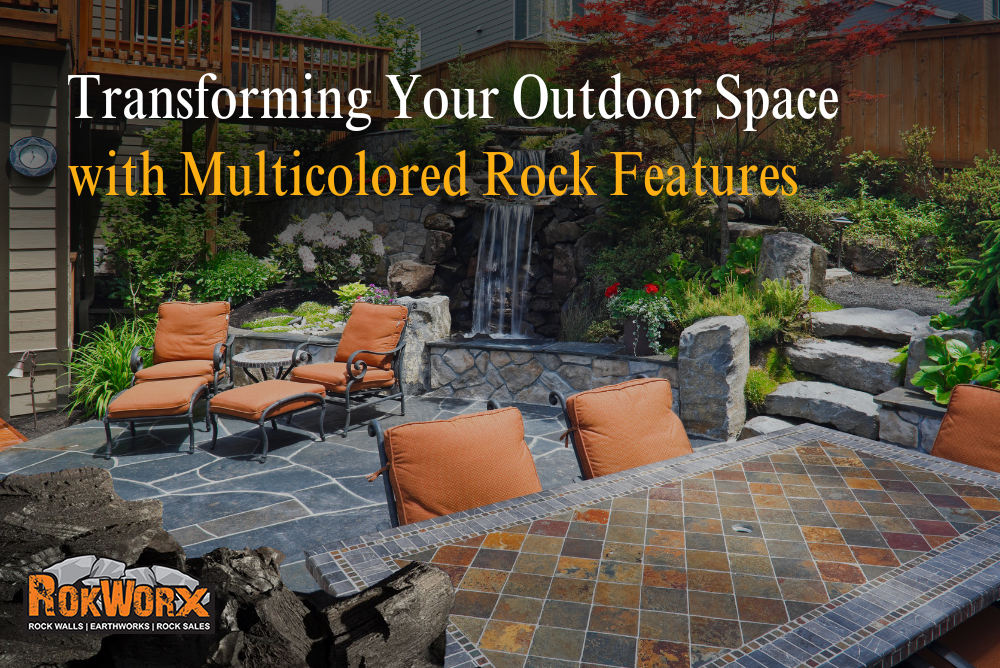Australians are spending more time outdoors than ever before, and outdoor living has evolved from a backyard barbie to fully styled garden experiences. Whether it’s a small city courtyard or a sprawling regional property, homeowners are chasing beauty, functionality and low maintenance in equal measure. Enter multicoloured rock features—a design element growing in popularity across landscaping circles, especially in landscaping rocks in Melbourne.
These vibrant stones don’t just serve a functional purpose—they breathe life into dull spaces, boost property value and add that hard-to-find blend of structure and flow. Let’s break down how to use multicoloured rock features to revamp your outdoor space while keeping it uniquely yours.
Why Colour Matters in Garden Design
When you think of garden rocks, grey or brown probably come to mind. But the moment you add reds, whites, blues or even golden tones, the space begins to tell a story. Colour creates contrast and draws the eye where you want it to go. Done right, it makes small gardens feel larger and gives large areas a sense of cohesion.
Multicoloured rocks let you play with light and shadow. White or pale rocks reflect sunlight, brightening shaded corners. Darker hues ground the design and add depth. And when you mix colours in layers or patterns, you get a natural texture that can’t be faked with concrete or pavers.
For homeowners after colourful landscaping rocks to add visual interest, rock combinations allow more expression than plants alone. They require no watering, trimming or fertilising and retain their colour for years.
Types of Multicoloured Rocks and Their Best Uses
Not all rocks are created equal. When choosing materials, think about texture, size and how each type complements the rest of your space.
Here are a few popular options:
- River pebbles: These come in blends of white, tan, grey and rust. Perfect for pathways, drainage lines and Japanese-inspired gardens.
- Crushed granite: Offers earthy reds and browns. Best used for garden beds, driveways and fire pit zones.
- Scoria: Lightweight volcanic rock, usually dark red or black. Works well in succulent beds or xeriscapes.
- Quartz: Bright white or pinkish tones. Looks stunning around water features or modern patios.
One Melbourne-based project used a mix of white quartz and charcoal granite to border a minimalist courtyard. The high-contrast combination popped against timber decking and a grey rendered wall. It gave structure to the space without overpowering the plants.
You’ll also see designers using glass pebbles or recycled materials to create focal points. These are mostly for visual impact—not foot traffic—but they work beautifully in feature beds or decorative swales.
For anyone seeking creative ideas for using landscaping rocks, blending multiple rock types is a game changer. It opens doors for layering colour, playing with patterns and creating natural movement in the layout.
Benefits of Using Multicoloured Rocks in Outdoor Spaces
Rocks aren’t just a style statement—they serve practical purposes too. When you add colour to the mix, their value increases both aesthetically and functionally.
Here’s what you can expect:
- Low maintenance: Rocks don’t grow, rot or need mowing. A quick rake or rinse is usually enough.
- Water-wise landscaping: They reduce water usage by covering soil and keeping weeds at bay.
- Improved drainage: Rocks help water flow through heavy clay soils or direct runoff away from structures.
- Fire resistance: Unlike mulch or woodchips, rocks won’t catch fire—perfect for bushfire-prone areas.
- Longevity: Quality decorative rocks can last decades without fading or breaking down.
That’s not to say they’re perfect. Some options can shift over time, especially on slopes or uneven ground. Others absorb heat, which could affect nearby plants. Understanding the pros and cons of decorative rocks in landscaping helps you make smarter choices that suit your climate and goals.
How to Design with Colour Without Overdoing It
There’s a fine line between creative and chaotic. Too many colours can clash, making the garden feel busy or artificial. Start with one dominant colour and layer in 1–2 accent tones for contrast.
Try these tips to keep things balanced:
- Use neutrals as your base—think grey, beige or charcoal.
- Limit bold colours to focal points, like water features or entry paths.
- Echo colours from your home’s exterior, such as bricks or roof tiles, for harmony.
- Contrast rocks with plants, not just other rocks. Light rocks make green foliage pop.
A homeowner in Victoria used pink granite and black basalt to border a path leading to their pergola. They filled the in-between space with silver grass and creeping thyme. The result was a low-maintenance display that changed with the seasons but always looked polished.
Less is more when it comes to colour. Let the rocks guide the eye, not hijack the view.
Pairing Multicoloured Rocks with Native Plants
Australian natives are perfect companions for rock-heavy designs. They thrive in dry soils, offer unique shapes and colours, and need little upkeep.
Some ideal matches include:
- Kangaroo paw: Striking reds and yellows pop against darker stone beds.
- Grevillea: Compact varieties work well with crushed rock in front gardens.
- Westringia: A tidy hedge-like native that softens rock lines.
- Spinifex grasses: Bring movement and help bind loose stone areas.
The combination of rocks and natives creates habitat for birds, insects and lizards. It also mirrors the natural Aussie landscape, blending style with sustainability. Plus, many natives drop less debris than deciduous plants, keeping rocks cleaner.
Multicoloured Rock Features as Focal Points
Beyond borders and paths, rocks can become the stars of your garden. Feature walls, dry riverbeds and rock mosaics are growing in popularity for both new builds and retrofits.
Want to make a statement?
- Build a dry creek bed with blue-grey pebbles and white quartz as “foam.” Add driftwood or upright stones to mimic riverbanks.
- Create a rock mural in a raised bed or courtyard wall using different colours and shapes.
- Design a Zen garden using raked scoria, smooth boulders and subtle plantings.
Done well, these focal points don’t just look good—they set the tone for the entire space.
Practical Considerations Before Installation
Before you jump in, plan ahead. Rocks are heavy, permanent and can’t be moved easily once set.
Ask yourself:
- Is your base soil compacted and weed-free?
- Do you need edging to stop rocks from spreading?
- What depth of coverage gives the best result without waste?
- Will the colour stay true in full sun or wet conditions?
Also consider maintenance tools. A leaf blower helps clean larger rock areas. Weed matting underneath reduces unwanted growth but may impact soil health long term.
Professional help is often worth the cost for complex designs or tricky terrain. A landscaper can help you source materials, layer textures and get the best use out of your budget.
Future Trends in Rock Landscaping
Designers are leaning into sustainability. That means more eco-friendly rock landscaping approaches using locally sourced stone, recycled aggregates and permeable layouts that help manage stormwater.
We’re also seeing:
- Interactive designs: Paths that double as play areas or mindfulness zones.
- Smart lighting: LED lights tucked between rocks to highlight shape and colour at night.
- Seasonal blends: Rotating small amounts of coloured pebbles based on season or event themes.
These trends point to an outdoor future that’s equal parts beautiful, functional and earth-conscious.
FAQs
1) What are the best rocks for adding colour to a garden?
The best rocks for colour depend on the look you’re after. For warm tones, go with crushed granite or scoria. These provide red, orange and rust colours that work well with earthy designs. For cool tones, blue river pebbles or grey slate offer a modern feel. White quartz and marble chips are perfect for clean, bright contrasts. If you’re working in a shaded area, lighter colours help reflect light and keep things feeling open. Just remember, some rock types fade over time in harsh sunlight—so it’s important to choose UV-resistant options if you’re in a sun-heavy region. Whatever you pick, balance your rock colours with plant tones, paving and the exterior of your home.
2) Do coloured rocks fade over time?
Yes, some coloured rocks can fade, especially when exposed to strong sunlight and constant weathering. Natural stone usually holds up better than artificially dyed ones. Granite, basalt and quartz are great for durability. Lighter-coloured stones may get dirty faster, but they won’t lose their colour like painted or coated options. To reduce fading, consider sealing the rocks or choosing naturally pigmented materials. Placement also matters—rocks used under trees or shaded areas will last longer in terms of colour. Talk to your supplier about rock types with strong colour-fast properties if long-term vibrancy is your goal.
3) Can multicoloured rocks be used in driveways?
Absolutely. Multicoloured rocks work well in driveways, but it depends on the type. You’ll want angular, crushed rock with good compaction ability—like decomposed granite or crushed bluestone. These offer stability under tyre pressure. For aesthetics, you can layer or blend colours on top. Just make sure you’ve got proper sub-base preparation, especially if your driveway is sloped. Too-smooth rocks, like polished pebbles, are a slip hazard and shift too easily. Crushed rock blends give texture, traction and a visually appealing finish that stands out from plain gravel. You can even edge the driveway with contrasting stone for a finished look.
4) Are multicoloured rock features suitable for small spaces?
Definitely. In fact, coloured rocks are ideal for small spaces because they draw the eye and help define zones without adding clutter. You can use light tones to make tight areas feel larger or bold tones for dramatic contrast. Try creating layered pots with coloured rocks as top dressings, or build a mini dry creek bed that weaves through a garden bed. Even vertical features—like stacked rock walls—can be done in blended tones to add depth. Because rocks don’t need pruning or watering, they’re perfect for tight, low-maintenance gardens. Just stick to a simple palette to avoid making the area feel crowded.
5) What’s the best way to maintain coloured rocks in a garden?
Maintaining coloured rocks is straightforward. The biggest issues are dirt build-up and weeds. A blower or broom works well for removing leaf litter. For weeds, start with a good base—weed matting or a thick underlayer of crushed rock helps. Every few months, you can rinse rocks with a hose or pressure cleaner, depending on the type. Don’t use harsh chemicals—natural stone can be damaged by acid-based cleaners. If you’re using decorative rocks in high-traffic areas, some may shift over time. Just rake them back into place. With the right prep and occasional touch-up, your coloured rocks can stay fresh and striking for years.
Let Your Outdoor Space Speak in Colour
Multicoloured rock features aren’t just a trend—they’re a shift in how we see garden design. They let us build spaces that feel alive, structured and easy to maintain. Whether it’s a bold dry riverbed, a calm Zen layout or a bright garden border, these stones are tools for expression.
The future of outdoor design is textured, natural and grounded in smart choices. By using sustainable materials and thoughtful layouts, your garden becomes more than a space—it becomes an experience.
Visit Rokworx today and bring your outdoor space to life with a spectrum of stunning rock features that are built to last.
Please call us today for more information at (03) 9000 0588 or leave a message.



